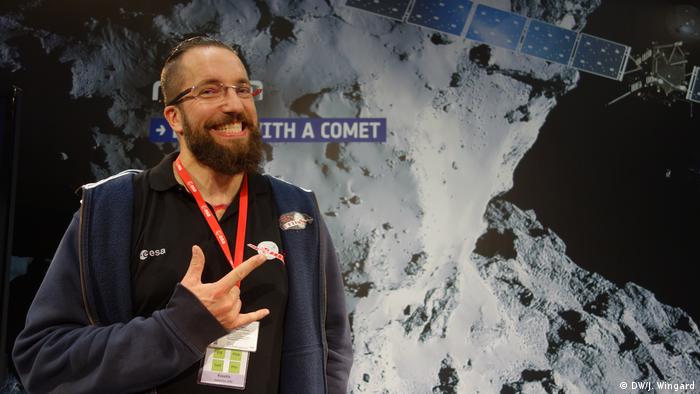Rosetta mision :when scientists......
- Albanian Shqip
- Amharic አማርኛ
- Arabic العربية
- Bengali বাংলা
- Bosnian B/H/S
- Bulgarian Български
- Chinese 中文
- Croatian Hrvatski
- Dari دری
- English English
- French Français
- German Deutsch
- Greek Ελληνικά
- Hausa Hausa
- Hindi हिन्दी
- Indonesian Bahasa Indonesia
SCIENCE
Rosetta mission: When scientists cry
It was a bittersweet moment for Matt Taylor, Rosetta project scientist at the European Space Agency, when his beloved probe crash-landed on Friday. He sat down with Jessie Wingard at mission control to relive the moment.
DW: Can you describe that moment for you in mission control leading up to the crash of Rosetta into comet 67P/Churyumov-Gerasimenko?
Matt Taylor: It's still really quite difficult for me to do. You know, you are watching and waiting for this thing to go. I was doing an interview in mission control around the time we got to minus 40 minutes - that's 40 minutes to go until nominal touchdown. At that point everyone was changing, the atmosphere changed. I don't know what it was - everyone knew the spacecraft had gone, we were just waiting for that signal to get to Earth and that imparted some kind of influence on my emotions for the rest of the day.
Now that Rosetta's mission is over, what's the most surprising data you found?
It really is difficult to pick something out. For me, the duck shape [of the comet] is really quite striking. But we have seen other objects, other comets like it with this bilobed nature like this duck shape. Molecular oxygen - that's also a big one for me. I find that exciting, because it shouldn't be there in that abundance. We weren't expecting it to be there because oxygen is a very friendly molecule, it likes to go and see other molecules and get together. It's there by itself, which means it has to have been captured in a certain way, at a certain time, under certain conditions. By having it there, you can constrain how the comet was formed many, many years ago. That is a fantastic measurement, and we have many more like that and we are going to be poring over this data for many decades to come.
That leads me into my next question: What is going to happen to the data you have collected over the course of the mission?
I was talking to Eberhard Grün, one of the grandfathers of the mission, and he was saying that we've got to this period - Rosetta ends today - however, let's make a comparison to the Rosetta Stone itself. The end of the mission is us actually getting our hands on the Rosetta Stone. Now we have to decipher the Rosetta Stone, that took 20 or so years to start deciphering that back in the day, and we are going to have a similar process in deciphering all this data. And now it's there for high school kids, people inspired by this mission, they can go on and work on this data. There is so much of it.
What has changed in our thinking when it comes to the way our solar system was formed?
This is an interesting one. If we go from the comet itself, a while ago we had ideas of separate regions where some of these small bodies were coming from. Over time it has evolved into a more blurred kind of feeling, whether you have asteroids only here, or comets only here - we're piecing that together. Rosetta raised many more questions, but there is also this thought: when we used to think of comets, [we thought of them as] just icy dust balls, or dusty ice balls, or snowballs. They are a much more diverse morphological system, something that is very reactive to the sun - we knew that, but the seasons are very important on the comet and how we now fit that with other comets is what we do now. We've calibrated our ground base measurements with the Rosetta measurements. Now we will be able to compare other comets.
By having this close relationship with this comet, seeing that it is built up from very small particles to the large-scale, perhaps fractal like in nature, our ideas of perhaps how comets could have formed in the first place [may have changed]. Has that happened for all of the comets? That has implications for how the comet formed, and therefore how the solar system formed, so we have, I think, much more of an idea of that - or at least we will start addressing that with the data that we have. So I wouldn't say we've now proven this, but it has definitely given us a new view in how we can address this from the simulation perspective.
Matt Taylor is a British-born astrophysicist currently working at the European Space Agency in Darmstadt, Germany. In his role at ESA, he was involved in landing the Philae Lander, the first spacecraft to land on a comet nucleus, on comet 67P/Churyumov-Gerasimenko. Taylor is the project scientist for the Rosetta mission.
This interview was conducted by Jessie Wingard. It has been condensed and edited for clarity.

Comments